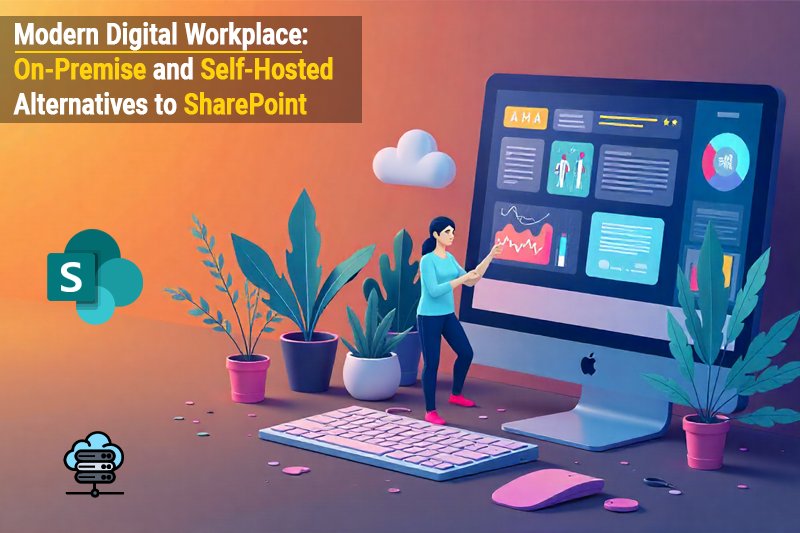- Patrice Lamarque
- February 4, 2016
Your Intranet is the Backbone of Your Digital Workplace
“So the digital workplace is not a fully automated machine that munches humans. It’s more a sophisticated work environment that is fueled by the human brain.“

Content
1. Intranet vs. Digital Workplace
2. Harnessing Signals
3. Seamless Access to Tools and Information
Modern intranets allow workers secure and seamless access to tools and information, on the go and on a wide range of mobile devices. If you can retrieve all your documents, be able to interact with your colleagues, start any work flow from anywhere, using any of your devices, a great deal of friction between you and your work is removed. Hence, a mobile-friendly intranet can enable agile work for the entire organization.
4. People First
Social intranets are user-centric by nature: they provide people the ability to connect by interest rather than solely through hierarchical relations. They also encourage interactions and ad hoc formation of groups. They are deeply conversational by nature, which fosters a sense of belonging. Ideas can emerge from these conversations and people tend to be highly motivated and engaged when their ideas are retained. The open nature of a social intranet enables knowledge to be spread across the organization and supports the emergence of natural leaders who will constantly share, animate, and inspire others.
5. Reducing Complexity
6. Beyond IT
Digital Workplace FAQs
What is a digital workplace?
A digital workplace is a next generation of intranet solutions or intranet 2.0 that is based on three pillars: communication, collaboration and information. In a way this definition is true but it doesn’t cover the whole spectrum of the term. Here are some definitions of digital workplace:
- An evolution of the intranet
- A user centric digital experience
What is an intranet?
intranet is a term used with abundance whenever the subject of internal communication and collaboration is brought up which makes defining it a bit challenging. In its simplest form, an intranet is an internal website for your organization. It is used mainly for top-down communication where employees can access corporate news, policies and announcements.
What is collaboration?
Collaboration is “the situation of two or more people working together to create or achieve the same thing”.
What are the different types of collaboration in business?
Here are some definitions of digital workplace:
- Team collaboration
- Cross-departmental and interdisciplinary collaboration
- Community collaboration
- Strategic partnerships and alliances
- Supply chain collaboration
What are the different types of intranet solutions?
To gather a thorough understanding of intranets and their different types, let’s walk through its history from the early days up to now:
- Intranet Portals
- Enterprise Social Netwrok (ESN)
- Intranet 2.0
What is the difference between intranets and extranets?
The main difference between intranets and extranets lays in the target audience. Intranets typically target users from a specific organization whereas extranets is the hub that can group users from multiple external organizations ranging from partners and suppliers all the way to clients
➝ Discover the real difference between intranet and extranet
What are the benefits of intranet solutions?
Different types of Intranet solutions from the early days up to the intranet 2.0 (commonly referred to as digital workplace solutions) bring a host of benefits to businesses of all sizes and industries. Below is a list of benefits often associated with intranets:
- Streamline internal communications
- Connect employees and eliminate silos
- Foster collaboration
- Improve knowledge sharing
- Recognize and reward employees
What are the different strategies for a successful intranet adoption?
Here are three different strategies for a successful intranet adoption:
- User focus strategy
- Global community management strategy
- Private communities focus strategy
- Tags: Digital workplace, intranet, Tips & Tricks
Related posts
- All
- eXo
- Digital workplace
- Employee engagement
- Open source
- Future of work
- Internal communication
- Collaboration
- News
- intranet
- workplace
- Knowledge management
- Employee experience
- Employee productivity
- onboarding
- Employee recognition
- Change management
- Cartoon
- Digital transformation
- Infographic
- Remote work
- Industry trends
- Product News
- Thought leadership
- Tips & Tricks
- Tutorial
- Uncategorized
Leave a Reply
( Your e-mail address will not be published)


